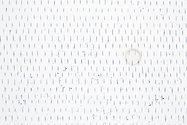John Hurrell – 24 September, 2013
From a distance Jansen's work looks like a rather peculiar damp stain some sloppy plasterer has walked away from. Moving closer you discover the clusters of lines and see that they are like those of the striations made by say a cheesegrater. They look like mesh or gauze - a screendoor perhaps - dense lines of incisions that you need to examine carefully in order to grasp that they are not regular.
In this large wall drawing Monique Jansen cleverly demonstrates part of the process of intaglio printmaking, as if the wall itself were a standard printing plate or block, with no impressions on huge paper sheets subsequently required. Her intricate, gridded, highly textured image has been made by preparing the wall surface with buffed white paint so that it is shiny and slippery. On this she has made thousands of vertical incisions with a very fine blade so that these cuts are in waves or horizontal rows - varying the spacing and length, and creating overall a cloudlike composition.
Then the whole wall is coated in thin dark blue paint, and the surface paint wiped off to leave the rest of the colour only inside the hollow grooves. Paint that has hardened on the wall surface is then sanded away or ground off with a machine so that the wall is white and polished. Any coincidental ‘found’ marks, such as where nails have been extracted, rawl plugs covered over with plaster, incidental repairs, or tiny nicks to the side of the slices, have been left to interact with the thin dark paint. Different parts of the vague, amorphous shape have varied densities, and different ‘weights’ of line length. Some areas are slightly mottled.
From a distance Jansen‘s work looks like a rather peculiar damp stain some sloppy plasterer has walked away from. Moving closer you discover the clusters of lines and see that they are like the striations made by say a cheesegrater. They look like mesh or gauze - a screendoor perhaps - dense lines of incisions that you need to examine carefully in order to grasp that they are not regular.
The shifting densities of line cluster is referred to in the gallery handout as ‘murmuration’, a term usually applied to large spiralling flocks of starlings where the flock shape expands and contracts with ripples and internally flowing eddies of migrating birds - thousands (in Europe, millions) of them.
If you stand too far back Jansen‘s drawing soon starts to disappear, its undulating rows of hairline cuts undetectable, even in bulk. Evanescent according to distance and lighting, there is in the handout a hint that because the site is a foyer where hundreds of people pass through on their way to various art or community projects, this embeds meaning into the nearby image, as if it were a stat counter. This suggests art is obligated to provide meaning by virtue of its location, some sort of narrative sense or purpose beyond just presenting itself.
It’s probably best to enjoy this sort of image as an inventive formal contrivance that exploits certain skills of perception its audience may possess, but with no wider social significance beyond that. It doesn’t require interpretation. Only internal comparisons. These are more than sufficient.
John Hurrell



 Advertising in this column
Advertising in this column Two Rooms presents a program of residencies and projects
Two Rooms presents a program of residencies and projects



This Discussion has 0 comments.
Comment
Participate
Register to Participate.
Sign in
Sign in to an existing account.